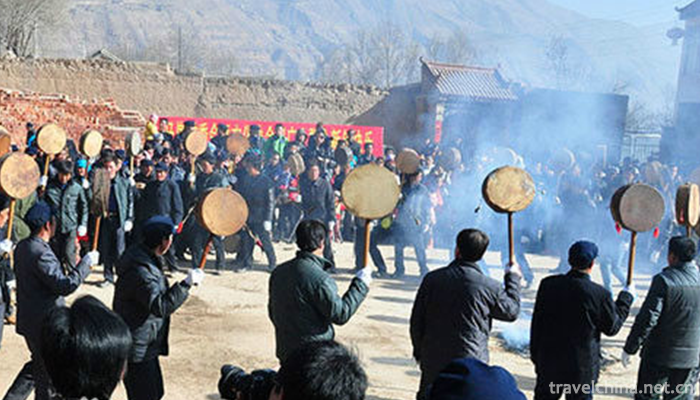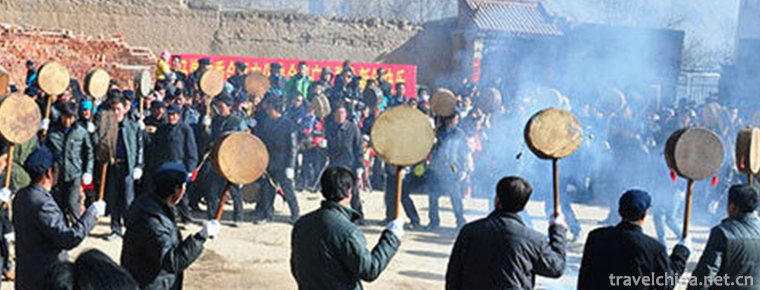Badang dance
Badang dance
Badang Dance is a kind of ancient folk dance, which originated from the ancient Qiang people's "Temple Festival" in Dingxi Minxian, southeastern Gansu Province. It is also a sacrificial ritual activity for local ancestors to pray for the coming year's smooth weather and abundant valleys.
On May 23, 2011, the Badang Dance declared by Minxian County of Gansu Province was listed in the third batch of national intangible cultural heritage list with the approval of the State Council.
historical origin
In some villages (towns) of Xiaozhai, Zhongzhai and Baozi in Minxian County, Gansu Province, an ancient collective dance of villagers is spreading. According to legend, Badang dance is a relic of Qiang and Tibetan culture, which was spread in Xuande period of Ming Dynasty. The word "Badang" is actually the dialectal pronunciation of the word "tiao", which is falsely passed down as Badang. Sow, that is, shake by hand. A snipe is a drum (hand drum).
artistic characteristics
Basic motion
The process of "Badang Dance" consists of "Anchang", "Jingshan God" and "Qijiele". "Anchang" is the first part of "Badang Dance". Under the leadership of "Chunba", the men of this village shake the long handle of "Badang Drum", sing the ancient Qiang language dance songs orally, and step on various steps. The formation begins to dance heartily and sing heartily. In the stage of security, the most common dancing steps are straight footsteps, Chunba Yang, Chunba Yang Sa, difficult to direct Yang Sa, male bus, difficult to get Ma Tan, Australian Ocean, Guai, Saai and so on. One kind of footwork, one kind of singing voice, the scene is solemn, warm, full of mystery. Anchang was followed by "Jingshan God". "Respecting Mountain God" is the most important part of "Badang Dance". At this stage, "Chunba" ignites a fire, leads dancers to "worship the Five Parties" and then dance heartily under the newly established swing. The footwork of "Jingshan God" is different from that of "Anchang". It mainly includes Aunaissa, Auda, Samuyang and Aoyou. The footwork of "Badang Dance" follows the "step song" of the Tang and Song Dynasties. The dance performance has a bright rhythm, strong clang and strong aesthetic sense. The singing is primitive and ancient, melodious and melodious, and full of strong Lyric interest. It is the concentrated expression of the unity and the struggle of the local people of Qiang, Tibet and Han nationalities. After the end of Jingshan god, it is the third part of "Badang Dance". All dancers begin to eat, drink and taste tea, and collectively perform Tibetan chorus. At the same time, they also sang wine songs, tea songs, and the crowd also participated in them, clapping hands or singing. Tibetan and Chinese are mixed together, with great momentum and magnificence.
Prop
The most important prop of "Badang Dance" is "Badang", which is a musical instrument created by the ancestors of primitive society by imitating sound, shape, audio and video. It is specially made of deerskin or sheepskin. "Badang" is an ancient musical instrument known as "Lei Huo", commonly known as "rattle drum" and "long handle drum", earlier than tanggu, hanging drum, waist drum, fan drum, about the diameter of Zhongzhai Guzhuang, Genzhen Road, Qiaojiagou, and other parts of the village community have one family. From textual research, "Badang" has a long history. In ancient times, "Badang" was a thing of gods, very noble. It was only used for dancing during the Spring Festival every year. The rest of the time was hanging on the wall. It could not be knocked at will. Otherwise, it would frighten the gods and bring disaster to the world.
train
In "Badang Dance", the most critical character is "Chunba". "Chunba" is a specially trained leader. They are the inheritors, inheritors and instructors of this ancient culture. One village is chosen and handed down from generation to generation. "Chunba" is the core of "Badang Dance". Before taking office, they should receive strict training in Tibetan Badang Dance Music and footwork. It is an important duty of Chunba to train "Chunba". Every year from December 2nd, the "Chunba" gathers men from all families in the village to divide their work, teaches them dance steps, beating skills of "Badang" and some lyrics, and rehearses the "Badang Dance". Since then, the annual grand celebration has begun.
Inheritance status
In 2004, Dingxi Baihua Performing Arts Co., Ltd. brought this ancient folk dance onto the stage and participated in the provincial program performance with cultural characteristics, which aroused repercussions.
In 2005, "Badang Dance" participated in the provincial Spring Festival Gala and was well received. Since then, "Badang Dance" has appeared in various literary and artistic performances, and is deeply loved by the audience.
In May 2011, "Badang Dance" was listed in the third batch of national intangible cultural heritage.
In September 2014, "Badang Dance" as the only drama in our province participated in the 12th China Folk Literature and Art Mountain Flower Award evaluation activities. It stood out in the fierce competition with its ancient primitive beauty, wild beauty, masculine rhythm beauty, melody beauty, unique regional style, distinct national characteristics and exquisite stage performance.
Inheritance significance
Badang dance, as an ancient folk dance, is the crystallization of the long-term labor wisdom of the working people and has great development value. It not only retains the extremely ancient primitive beauty and wild beauty, but also has the beauty of rhythm and rhythm of dance, full of masculinity. At the same time, Badang dance is also a symbol of national unity and harmony of Tibetan, Han and Qiang nationalities.


-
1.Daocheng County
Daocheng county is located in the southwestern edge of Sichuan Province, south of Ganzi. Located in the southeast of the Qinghai Tibet Plateau, the eastern side of Hengduan Mountains.
Time 2018-10-12 -
2.Kanas Scenic Area in Altay Area
Kanas Scenic Area is located in the middle section of Altai Mountain in Xinjiang, which is located in the border area between China and Kazakhstan, Russia and Mongolia
Time 2018-12-12 -
3.Huangpi Mulan Cultural Ecotourism Area
Wuhan Huangpi Mulan Cultural Eco-tourism Area is located in Huangpi District, Wuhan City, Hubei Province, including Mulan Mountain, Mulan Tianchi, Mulan Grassland
Time 2018-12-12 -
4.Dongping Lake Scenic Spot
The total area of Dongping Lake Scenic Spot is 627 square kilometers, the annual water surface is 209 square kilometers, the average water depth is 2.5 meters, and the total water storage is 4 billion
Time 2018-12-20 -
5.Ancient town of Guandu
Guandu Town, located in the Southeastern Suburb of Kunming, is one of the famous historical and cultural ancient towns in Kunming. Guandu ancient town gate (big archway) is located in the southeastern
Time 2019-01-13 -
6.Qingdao Polar Ocean World
Qingdao Polar Marine World is located at 60 Donghai East Road, Laoshan District, Qingdao City, Shandong Province. It is a large marine world complex integrating leisure
Time 2019-02-07 -
7.Dong embroidery
Dong embroidery is an important branch of Chinese minority embroidery, which uses a needle to puncture and attaches various colored silk or cotton threads to the surface of the fabric to form various
Time 2019-04-27 -
8.Hainan Zhai Opera
Hainan Zhai Opera is a traditional sacrificial ritual drama in Hainan Province. It is similar to the Nuo Opera in northern China. It is known as "Nuo Opera in the north
Time 2019-05-02 -
9.Tiger dance shua laohu
Tiger dance, also known as "playing tiger" ("playing" Jiaozuo dialect refers to "playing" and "performing"), is said to have appeared in the Western Han Dynasty
Time 2019-06-15 -
10.Sayerhao of Tujia Nationality
"Sayeer Hao" of Tujia nationality in Changyang, Hubei Province is a kind of sacrificial song and dance of Tujia nationality in the middle reaches of Qingjiang River valley. "Sayer Haw&q
Time 2019-06-23 -
11.And then I met him 66 Hu Tik Tok Songs 2020 Hot Songs
Hey, do you still think of me Like I cry sometimes at night I was so happy that I thought you were the end To give you everything Time is always disobedient and starts to play dumb
Time 2020-05-21 -
12.Leshan culture
By the end of 2018, Leshan has 12 mass cultural centers, 12 public libraries, 10 museums, 218 cultural stations and 29 City cinemas. There are 12 free libraries, 12 cultural centers, 218 township cultural stations and 3 museums. 2003 rural libraries and 276
Time 2020-12-17